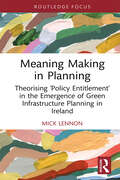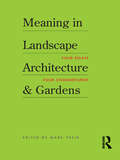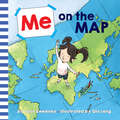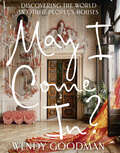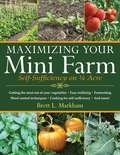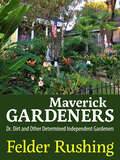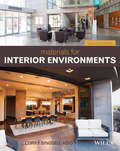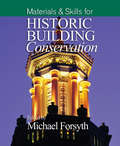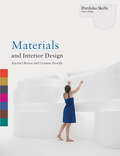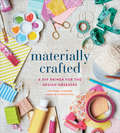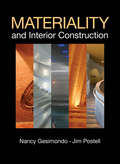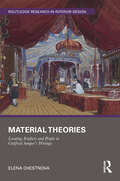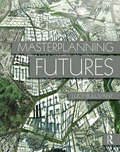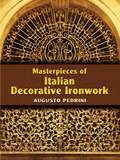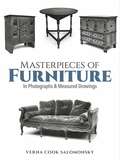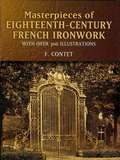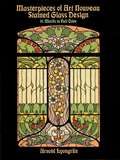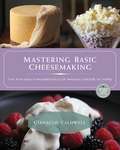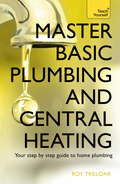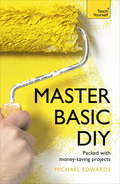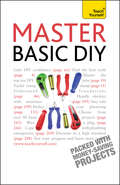- Table View
- List View
Meaning Making in Planning: Theorising ‘Policy Entitlement’ in the Emergence of Green Infrastructure Planning in Ireland
by Mick LennonPlanning theorists normally focus on issues of contest and critique. The field of planning theory is thereby replete with studies of conflict, collaboration and criticism. Considerably less critical attention is afforded to policy approaches that emerge, evolve and are widely adopted in the apparent absence of discord. This book addresses this knowledge gap. A case study of the emergence of green infrastructure policy in Ireland is used to both inform and illustrate a theory of ‘Policy Entitlement’. This interpretive approach focuses on meaning making in context to explain the counter-intuitive processes through which a new policy concept can emerge and reprofile planning activities by producing the seemingly pre-existing objective reality to which such policy is then applied and the discipline (re)orientated. This approach accounts for how a new planning concept can appear to resolve problematic policy ambiguity by suspending disagreement on issues where dispute could be expected. This book will be of interest to those studying planning theory and the policy process, as well as those concerned with the undertheorized but swift rise to prominence of green infrastructure planning.
Meaning in Landscape Architecture and Gardens
by Laurie Olin Marc Treib Susan Herrington Jane GilletteWhile we all live our lives in designed landscapes of various types, only on occasion do we consider what these landscapes mean to us and how they have acquired that significance. Can a landscape architect or garden designer really imbue new settings with meaning, or does meaning evolve over time, created by those who perceive and use these landscapes? What role does the selection and arrangement of plants and hard materials play in this process and just where does the passage of time enter into the equation? These questions collectively provide the core material for Meaning in Landscape Architecture and Gardens, a compendium of four landmark essays written over a period of twenty years by leading scholars in the field of landscape architecture. New commentaries by the authors accompany each of the essays and reflect on the thinking behind them as well as the evolution of the author’s thoughts since their original publication. Although the central theme of these writings is landscape architecture broadly taken, the principal subject of several essays and commentaries is the garden, a subject historically plentiful in allusions and metaphors. As a whole Meaning in Landscape Architecture and Gardens offers the general reader as well as the professional a rich source of ideas about the designed landscape and the ways by which we perceive, consider, react, and dwell within them – and what they mean to us. The essays have been perennial favorites in landscape courses since their original publication in Landscape Journal. Bringing them together – bolstered by the new commentaries – creates a book valuable to all those creating gardens and landscapes, as well as those teaching and studying these subjects.
Me on the Map (Me. . Books! Ser.)
by Joan SweeneyMaps can show you where you are anywhere in the world! A beloved bestseller that helps children discover their place on the planet, now refreshed with new art from Qin Leng. Where are you? Where is your room? Where is your home? Where is your town? This playful introduction to maps shows children how easy it is to find where they live and how they fit in to the larger world. Filled with fun and adorable new illustrations by Qin Leng, this repackage of Me on the Map will show readers how easy it is to find the places they know and love with help from a map.
May I Come In?: Discovering the World in Other People's Houses
by Wendy GoodmanNew York magazine&’s interiors editor shares some of her most memorable house profiles in this stunning and inspiring visual tour. For May I Come In?, design editor extraordinaire Wendy Goodman visits seventy homes that express their owners&’ spirit and passions. In this pantheon, imagination and originality hold sway: Artists and eccentrics are the equals of aristocrats and the mandarins of design. Alba Clemente&’s closet is a Renaissance theater; Amy Sedaris built a playroom (but not for children); Andrew Solomon houses his guests in an igloo; Richard Avedon&’s private walls were bulletin boards; Kathy Ruttenberg&’s house is an animal kingdom; Jay Maisel called a former bank with seventy-two rooms home. Every room has a story to tell and a purpose for being. A self-described design hunter, Goodman spent thirty years seeking extraordinary living spaces. In her long career, she has found three things to be true. The first is that curiosity and never giving up will get you everywhere. The second is what Diana Vreeland stated best when she wrote, &“Few things are more fascinating than the opportunity to see how other people live during private hours.&” The third is that houses never lie. These principles underscore her search for individuality, human interest, and authenticity in design.May I Come In? is profusely illustrated with superb images by leading interior photographers, as well as Goodman&’s own snapshots and memorabilia related to her quests. It is an irresistible visual record of the art of living by one of its most astute observers.&“Page after page reveals interiors that practically vibrate with charisma, while others wax a poetic minimalism that, despite a lack of things, overwhelm with grace.&” —Vogue &“When it comes to the New York design scene, Wendy Goodman is positively an institution.&” —Town & Country
Maximizing Your Mini Farm: Self-Sufficiency on 1/4 Acre
by Brett L. MarkhamMini farming describes a holistic approach to small-area farming that will show you how to produce 85 percent of an average family's food on just a quarter acre-and earn $10,000 in cash annually while spending less than half the time that an ordinary job would require. Now expanding exponentially on his bestselling Mini Farming: Self-Sufficiency on ¼ Acre, Brett Markham gives you tips, tricks, and planning advice on how to make the most of your mini farm. New topics include: -Soil and Fertility yy Tools and Techniques-Planting Guides and Seeders-Easy Trellising -Weed Control Techniques-Greater Food Self-Sufficiency-Making Your Own Country Wines-Making Your Own Vinegars -Making Cheese at Home-Cooking for Self-Sufficiency Keep your costs down and production high with this complete guide to maximizing your mini farm-whether it's a rooftop urban garden, a suburban backyard, or a more substantial plot of land. Materials, tools, and techniques are detailed with tables, diagrams, and 200 color illustrations and author photographs.
Maverick Gardeners: Dr. Dirt and Other Determined Independent Gardeners
by Felder Rushing“Be forewarned that this book honors people like the woman in my hometown who paints the numbers of her favorite NASCAR drivers on her elephant ears, and a Tokyo gardener with over a hundred bonsai plants.” So says renowned garden journalist Felder Rushing in his new book Maverick Gardeners: Dr. Dirt and Other Determined Independent Gardeners. In this book, Felder delves deeply into the psychology of what motivates and sustains the Keepers of the Garden Flame. For thousands of years, a loosely connected web of unique, nontraditional gardeners has bonded people across race, culture, language, and other social conventions through sharing unique plants and stories. Found in nearly every neighborhood worldwide, these “determined independent gardeners” (DIGrs) are typically nonjoiners who garden simply and exuberantly, eschewing customary horticultural standards in their amateur pursuits of personal bliss. Included in Maverick Gardeners are classic “passalong plant” lists, a dollop of how-to, numerous color photographs, and thought-provoking essays on quintessential tools, sharing with others, getting away with wildflowers in suburbia, and organizing a plant swap. The centerpiece of this unique gardening journey is the no-holds-barred story of a ten-year cross-cultural collaboration between the horticulturist author and a flamboyant rebellious gardener who called himself Dirt. Through swapping plants and garden lore—and rubbing shoulders with fellow DIGrs—they unraveled their shared humanity. From the practical to the inspiring, Maverick Gardeners is the perfect book for those nonconformist souls who see no sense in trying to fit in and follow the footpaths of others.
Materials for Interior Environments
by Corky BinggeliOrganized by types of materials and applications, this guide helps designers successfully address material evaluation and selection of interior components. Engagingly written, highly detailed, and helpfully illustrated with more than 550 color illustrations, Materials for Interior Environments is a comprehensive guide to everything a designer needs to know about the materials available for interiors--from aesthetic qualities to manufacturing and fabrication, applications, installation and maintenance, and specifications for materials used in commercial and residential applications.
Materials and Skills for Historic Building Conservation (Historic Building Conservation)
by Michael ForsythThis book is the third in a series of volumes that combine conservation philosophy in the built environment with knowledge of traditional materials, and structural and constructional conservation techniques and technology: Understanding Historic Building Conservation Structures & Construction in Historic Building Conservation Materials & Skills for Historic Building Conservation The series aims to introduce each aspect of conservation and to provide concise, basic and up-to-date knowledge for architects, surveyors and engineers as well as for commissioning client bodies, managers and advisors. In each book, Michael Forsyth draws together chapters by leading architects, structural engineers and related professionals to reflect the interdisciplinary nature of conservation work. The books are structured to be of direct practical application, taking the reader through the process of historic building conservation and emphasising throughout the integrative teamwork involved. The present volume - Materials & Skills for Historic Building Conservation – describes the characteristics and process of decay of traditional materials which inform the selection of appropriate repair techniques. It provides essential information on the properties of the principal traditional external building materials. Their availability, sourcing and environmental impact is covered, as well as the causes of erosion and decay, and the skills required for their application on conservation projects. It covers the main most commonly used materials and conservation techniques including stone, brickwork, lime products, concrete, iron and steel, timber, wattle and daub, and glass, Thirteen chapters written by the experts present today's key issues in materials and skills for historic building conservation: Gus Astley, Patrick Baty, Charley Brentnall, Michael Bussell, Michael Forsyth, Tony Graham, Chris Harris, David McLaughlin, Brian Ridout, Mike Stock, Geoff Wallis, Ian Williams, Rory Young
Materials and Interior Design
by Rachael BrownThe choice of materials is critical to the success of an interior. This book examines every aspect of the the use of materials in interior design, from initial concept and selection to visual representation and practical application. Following a brief introduction, the first five sections offer historical context and detailed guidance on selection, application, representation, communication, and sources, while the sixth and final section features case studies by international interior designers. The book includes useful step-by-step sequences, information on properties and sustainability, and a list of resources, online archives and sample libraries. It is an invaluable practical and inspirational guide for interior design students.
Materials and Interior Design (Portfolio Skills)
by Lorraine Farrelly Rachael BrownThe choice of materials is critical to the success of an interior. This book examines every aspect of the the use of materials in interior design, from initial concept and selection to visual representation and practical application. Following a brief introduction, the first five sections offer historical context and detailed guidance on selection, application, representation, communication, and sources, while the sixth and final section features case studies by international interior designers. The book includes useful step-by-step sequences, information on properties and sustainability, and a list of resources, online archives and sample libraries. It is an invaluable practical and inspirational guide for interior design students.
Materially Crafted: A DIY Primer for the Design-Obsessed
by Victoria Hudgins“Perfect for anyone embracing their crafty side for the first time (or those who just want to keep developing their design chops)” (HGTV). Design enthusiasts are bombarded with beautiful inspiration at every turn, but many lack the foundation necessary to recreate their dream projects. In Materially Crafted, Victoria Hudgins, creator of the popular design blog A Subtle Revelry, uncovers the best and least intimidating ways to work with the most popular crafting materials—from spray paint and concrete to thread, wax, and paper—and presents more than thirty easy projects to get everyone started. Peppered with Hudgins’s tips for “merrymaking the everyday" (using simple DIY ideas to live life more joyfully) plus inspirational photos of projects created by other prominent bloggers, Materially Crafted is an indispensable guide for a new generation of design enthusiasts looking to DIY their own distinctive style. “Her book focuses on materials and great ways (including 30 main projects) to transform them into something special.” —Design*Sponge
Materiality and Interior Construction
by Nancy Gesimondo Jim PostellA comprehensive reference of materials for interior designers and architects Choosing the right material for the right purpose is a critical-and often overlooked-aspect in the larger context of designing buildings and interior spaces. When specified and executed properly, materials support and enhance a project's overall theme, and infuse interior space with a solid foundation that balances visual poetry and functionality. Materiality and Interior Construction imparts essential knowledge on how materials contribute to the construction and fabrication of floors, partitions, ceilings, and millwork, with thorough coverage of the important characteristics and properties of building materials and finishes. Individual coverage of the key characteristics of each material explores the advantages and disadvantages of using specific materials and construction assemblies, while helping readers discover how to make every building element count. In addition, Materiality and Interior Construction: Is highly illustrated throughout to show material properties and building assemblies Supplies rankings and information on the "green" attributes of each material so that designers can make informed decisions for specifications Is organized by application for easy and quick access to information Includes a companion website, featuring an extensive online image bank of materials and assemblies Rather than a typical catalog of materials, Materiality and Interior Construction is efficiently organized so that the reader is guided directly to the options for the location or assembly they are considering. Reliable and easy to use, Materiality and Interior Construction is a one-stop, comprehensive reference for hundreds of commonly used materials and their integration as building components-and an invaluable resource that every interior designer or architect should add to their set of tools.
Material Theories: Locating Artefacts and People in Gottfried Semper's Writings (Routledge Research in Interior Design)
by Elena ChestnovaMaterial Theories takes a radically new approach to well-established thinking on nineteenth-century architecture and design by investigating Gottfried Semper’s classic ideas about dressing, metamorphosis of material, and cultural development, culminating in his two-volume publication Style. This book demonstrates how Semper’s theories crystallised among his encounters with material things of the late 1840s and early 1850s. It examines several discursive frameworks and phenomena which shaped the attitude to artefacts in Europe in the mid-nineteenth century, and which were specifically pertinent to Semper’s evolution: archaeology and antiquarianism, the domestic interior, print media, collections, and the embodied relationship between the designer and their work. For the first time, this book examines the construction of a design theory not only as an intellectual endeavour but also as a process of confrontation with material things. It employs recent approaches to material culture, in particular Thing Theory, in order to show that Semper’s artefact references constituted his ideas, rather than simply giving impetus to them. It will be an important investigation for academics and researchers interested in interior design history, as well as scholars of material culture and history of design theory.
Masterplanning Futures
by Lucy BullivantWinner of the Urban Design Group's 2014 Book of the Year Award! In the past, spatial masterplans for cities have been fixed blueprints realized as physical form through conventional top down processes. These frequently disregarded existing social and cultural structures, while the old modernist planning model zoned space for home and work. At a time of urban growth, these models are now being replaced by more adaptable, mixed use plans dealing holistically with the physical, social and economic revival of districts, cities and regions. Through today’s public participative approaches and using technologically enabled tools, contemporary masterplanning instruments embody fresh principles, giving cities a greater resilience and capacity for social integration and change in the future. Lucy Bullivant analyses the ideals and processes of international masterplans, and their role in the evolution of many different types of urban contexts in both the developed and developing world. Among the book’s key themes are landscape-driven schemes, social equity through the reevaluation of spatial planning, and the evolution of strategies responding to a range of ecological issues and the demands of social growth. Drawing on first-hand accounts and illustrated throughout with colour photographs, plans and visualizations, the book includes twenty essays introduced by an extensive overview of the field and its objectives. These investigate plans including one-north Singapore, Masdar City in Abu Dhabi, Xochimilco in Mexico City and Waterfront Seattle, illuminating their distinct yet complementary integrated strategies. This is a key book for those interested in today’s multiscalar masterplanning and conceptually advanced methodologies and principles being applied to meet the challenges and opportunities of the urbanizing world. The author's research was enabled by grants from the Commission for Architecture and the Built Environment (CABE), the SfA (the Netherlands Architecture Fund), the Danish Embassy and support from the Alfred Herrhausen Society.
Masterpieces of Italian Decorative Ironwork (Dover Jewelry and Metalwork)
by Augusto PedriniThis magnificently illustrated volume showcases elegant examples of ironwork designs by five centuries of Italian masters. Spanning the fourteenth through the eighteenth centuries, the collection encompasses both simple and elaborate ornaments for doors, windows, gates, balcony and staircase railings, and other architectural features. A remarkable variety of motifs are depicted--from gracefully executed florals and foliated elements, to exquisite swirls and curls, and striking portrayals of mythical beasts.A dazzling treasury of ornamental ironwork, this archive of royalty-free motifs will delight lovers of antiques, commercial artists, and anyone intrigued by decorative flourishes from the past.
Masterpieces of Furniture in Photographs and Measured Drawings: Third Edition
by Verna Cook SalomonskyThis well-known reference work has been consulted by generations of collectors, curators, dealers, historians, and craftsmen, and it remains in use decades after its initial publication. Photographs and measured drawings of the most striking furniture pieces of the sixteenth through nineteenth centuries constitute the major part of the book; the accompanying text indicates stylistic features and developments, prototypes, types of wood, function, and location of the original. Selected mainly from collections in the Metropolitan Museum of Art, Boston Museum of Fine Arts, and the Museum of the Rhode Island School of Design, the objects include chests, tables, chairs, dressing tables, desks, highboys, commodes, couches, and other furniture. Periods and styles include Colonial American, Duncan Phyfe, Windsor, Sheraton, Hepplewhite, Chippendale, Louis XIV, eighteenth-century Dutch, sixteenth-century Italian, and representatives of other eras. The book's most outstanding features are the measured drawings for each piece of furniture. Accurate to the nearest 1/16th of an inch, these drawings are especially valuable for woodworkers creating detailed replicas.
Masterpieces of Eighteenth-Century French Ironwork: With Over 300 Illustrations
by F. ContetThis magnificent display of all 166 plates from an extremely rare set of portfolios depicts scores of examples of the ironworker's art, among them beautiful gates, balustrades, balcony railings, window grilles, church screens, and lantern holders. A superb collection of royalty-free images for use by designers, architecture enthusiasts, and lovers of antiques.
Masterpieces of Art Nouveau Stained Glass Design: 91 Motifs in Full Color (Dover Pictorial Archive)
by Arnold LyongrünMagnificent motifs reproduced from rare original edition: florals, foliates, female figures, pastoral landscapes, more. Ideas for craftspeople and designers.
Mastering Basic Cheesemaking: The Fun and Fundamentals of Making Cheese at Home (Mother Earth News Books for Wiser Living)
by Gianaclis CaldwellThe craft of home cheesemaking is exploding in popularity. However, most "beginner" books are essentially loosely organized collections of recipes which lack a progressive approach to teaching the fundamentals of this exciting and satisfying traditional skill. <P><P>Mastering Basic Cheesemaking provides a complete hands-on guide to making cheese and other fermented dairy products from scratch, geared toward helping the novice cheesemaker to develop the intuition and abilities to position them for success, especially in the real world of the home kitchen.
Master Basic Plumbing And Central Heating: Teach Yourself (Teach Yourself General)
by Roy TreloarMaster Basic Plumbing and Central Heating is a straightforward guide to such easy, yet frequently mysterious, tasks as replacing a radiator or changing a tap; it also offers ample help for such crises as blocked toilets and frozen pipes. It will tell you all about the layout of a house and water system, then show you how to undertake basic emergency repairs; complete small and achievable projects; and even tackle bigger things like installing a bathroom suite or plumbing in a dishwasher. With plenty of illustrations, step-by-step guides, a full glossary and a whole chapter on how and when to call in expert help, this book is perfect for you if you dread the expense of call-out charges and labour. NOT GOT MUCH TIME? One, five and ten-minute introductions to key principles to get you started. AUTHOR INSIGHTS Lots of instant help with common problems and quick tips for success, based on the author's many years of experience. TEST YOURSELF Tests in the book and online to keep track of your progress. EXTEND YOUR KNOWLEDGE Extra online articles at www.teachyourself.com to give you a richer understanding of plumbing and heating. FIVE THINGS TO REMEMBER Quick refreshers to help you remember the key facts. TRY THIS Innovative exercises illustrate what you've learnt and how to use it.
Master Basic Plumbing And Central Heating: A quick guide to plumbing and heating jobs, including basic emergency repairs (Teach Yourself General Ser.)
by Roy TreloarThis guide to the basics of plumbing and central heating is designed for complete amateurs, and written by one of the most experienced plumbing tutors in the country.Whether you are attempting projects such as installing a new bathroom or plumbing in a new dishwasher, or just need to understand enough to do essential repairs and fixes, this is the book for you. It includes step-by-step guides to sorting out the most common plumbing problems, and comprehensive coverage of the key tasks, all based on a straightforward introduction to the layout of your house and water system. In addition, it has plenty of illustrations, a full glossary, a whole chapter on how and who to call for help, a guide to the necessary toolkit and a list of the top ten plumbing emergencies.
Master Basic DIY: Teach Yourself
by DIY Doctor**** New edition fully revised and updated, including new material on the most popular questions and household problems ****Master Basic DIY explains all the basic tasks and gives you all the information you need to undertake essential decorating and maintenance in an informed and sensible manner. It offers insight into complex options and methods, and is full of practical information and indispensable tips to enable you to quickly see the results reflected in your DIY projects.Master Basic DIY includes:Part one - The basicsChapter 1: ToolsChapter 2: Top ten DIY jobs for homeownersChapter 3: Sequence of workChapter 4: From foundations to the ground floor slabChapter 5: Brickwork and blockworkChapter 6: Roofs, roof coverings and loft conversionsChapter 7: Home electricsChapter 8: Plumbing, central heating and drainageChapter 9: Plastering, plasterboard and partition walls Part two - ProjectsChapter 10: BasicsChapter 11: OutsideChapter 12: InsideChapter 13: ElectricalChapter 14: PlumbingChapter 15: Decorating
Master Basic DIY: Teach Yourself
by DIY DoctorMaster Basic DIY explains all the basic tasks and gives you all the information you need to undertake essential decorating and maintenance in an informed and sensible manner. It offers insight into complex options and methods, and is full of practical information and indispensable tips to enable you to quickly see the results reflected in your DIY projects.NOT GOT MUCH TIME?One, five and ten-minute introductions to key principles to get you started.AUTHOR INSIGHTSLots of instant help with common problems and quick tips for success, based on the author's many years of experience.TEST YOURSELFTests in the book and online to keep track of your progress.EXTEND YOUR KNOWLEDGEExtra online articles at www.teachyourself.com to give you a richer understanding of basic DIY.FIVE THINGS TO REMEMBERQuick refreshers to help you remember the key facts.TRY THISInnovative exercises illustrate what you've learnt and how to use it.
Master Basic DIY: Teach Yourself
by Diy Doctor**** New edition fully revised and updated, including new material on the most popular questions and household problems **** Master Basic DIY explains all the basic tasks and gives you all the information you need to undertake essential decorating and maintenance in an informed and sensible manner. It offers insight into complex options and methods, and is full of practical information and indispensable tips to enable you to quickly see the results reflected in your DIY projects. Master Basic DIY includes: Part one - The basics Chapter 1: Tools Chapter 2: Top ten DIY jobs for homeowners Chapter 3: Sequence of work Chapter 4: From foundations to the ground floor slab Chapter 5: Brickwork and blockwork Chapter 6: Roofs, roof coverings and loft conversions Chapter 7: Home electrics Chapter 8: Plumbing, central heating and drainage Chapter 9: Plastering, plasterboard and partition walls Part two - Projects Chapter 10: Basics Chapter 11: Outside Chapter 12: Inside Chapter 13: Electrical Chapter 14: Plumbing Chapter 15: Decorating
Master Basic DIY: Teach Yourself (Teach Yourself General)
by Diy DoctorMaster Basic DIY explains all the basic tasks and gives you all the information you need to undertake essential decorating and maintenance in an informed and sensible manner. It offers insight into complex options and methods, and is full of practical information and indispensable tips to enable you to quickly see the results reflected in your DIY projects.NOT GOT MUCH TIME?One, five and ten-minute introductions to key principles to get you started.AUTHOR INSIGHTSLots of instant help with common problems and quick tips for success, based on the author's many years of experience.TEST YOURSELFTests in the book and online to keep track of your progress.EXTEND YOUR KNOWLEDGEExtra online articles at www.teachyourself.com to give you a richer understanding of basic DIY.FIVE THINGS TO REMEMBERQuick refreshers to help you remember the key facts.TRY THISInnovative exercises illustrate what you've learnt and how to use it.
